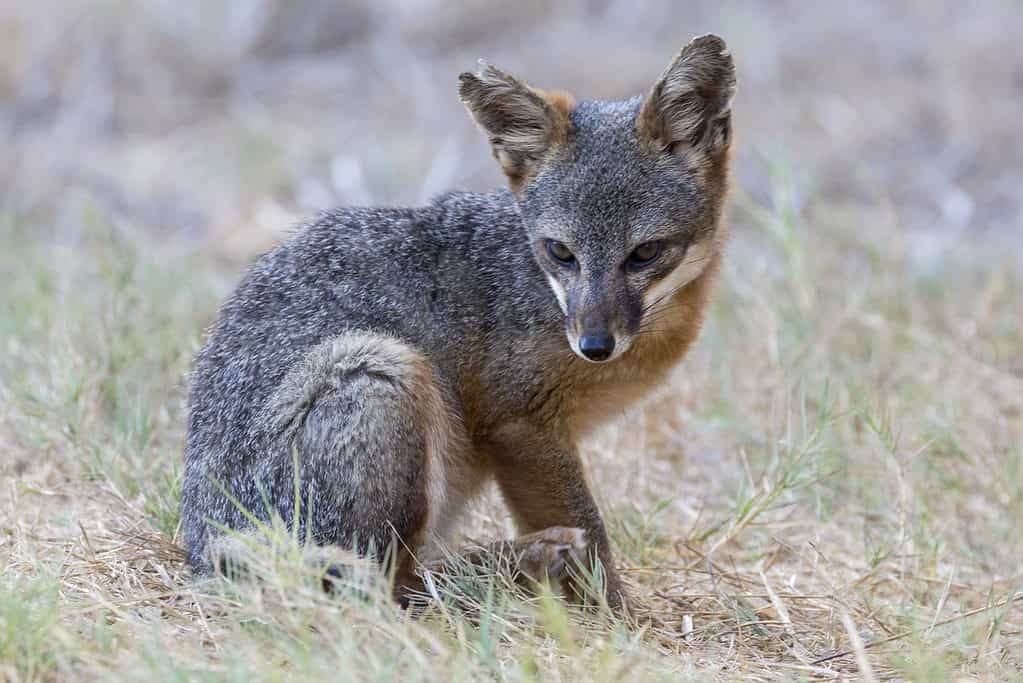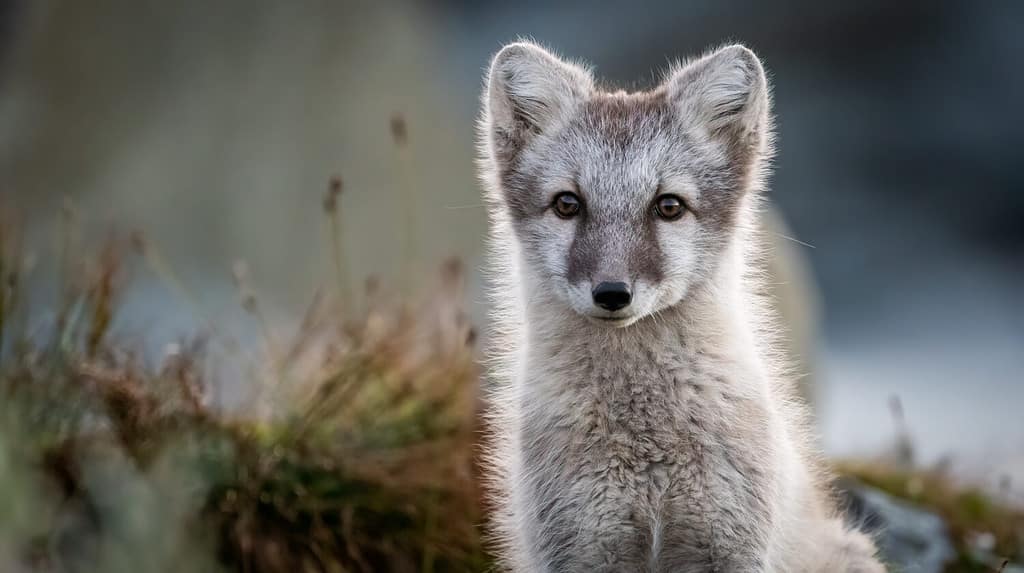Foxes are very successful animals that live on most of the world’s continents. They are omnivores that hunt for meat and also eat berries and vegetation, but what colors can foxes be?
Good question!
It depends on their environment, the season, and the effects of selective human breeding.

©Giedriius/Shutterstock.com
What is a Fox?
Before we dive in, let’s take a quick look at what a fox is, because this will help us understand why there is a color range.
Foxes are members of the Canidae family. They are smaller than wolves with pointed snouts, upright ears, and fantastically bushy tails. Males are called dogs or tods, females are vixens, and babies are cubs or kits. There are 47 species worldwide and four species live in North America. They are the red fox, gray fox, arctic fox, and kit fox.
When foxes hunt, they use stealth, sneaking up on their victim before pouncing on it. Foxes are versatile animals that live in forests, mountains, deserts, tundra, and even urban areas. They survive by changing their habits and behavior to fit in.

©Parque Tepuhueico / CC BY-SA 4.0 – License
What Color Can Foxes Be?
Fox colors range from red, gray, tan, white, black, and a combination of all these colors.
Why Are Foxes Different Colors?
There are several reasons why foxes are not all the same color:

©bhavdip12/Shutterstock.com
Different Species
Different species are different colors. For example, a red fox is a different species from a gray fox, so there are fur color differences.
In addition, fox pelts are bred for human consumption on fur farms, so human influence has created certain colored foxes for profit.
Camouflage
Wild foxes are secretive animals that avoid human contact and they are also prey to mountain lions, lynxes, mountain eagles, bears, wolves, and coyotes. Fur color that matches the environment helps them hide.
Foxes are also adept hunters, that blend into their environment to hunt hares, voles, rodents, birds, and aquatic animals. A coat that matches their surrounding helps them eat regularly.
Seasonal Changes
Foxes change color depending on the season! This relates to camouflage. For example, arctic foxes turn white to match winter snowfall, but they are gray in summer to match the multi-hued tundras.
Every fox is different! Even the same species have color variations. Like our domestic cats and dogs, fur markings vary and no two individuals are the same.
Let’s take a look at the different fox fur colors.
Different Colors

©iStock.com/BlueBarronPhoto
Red
Red foxes are the largest and most common fox species on the planet. They inhabit all US states including Alaska.
These clever canines are not red, but various shades of orange, gold, and brown with a white belly and white-tipped tail. Their legs are most often black and in winter, their fur turns darker brown.
But wait!
Not all red foxes are orange! Here are some of the species variations:
Silver and Black
A silver and black red fox is called a ‘color morph’. It’s a red fox in species, but not in color! Silver and black red foxes usually have silver upper coats, black legs and black ears, and a white-tipped tail. This makes them look like small wolves.
Cross Color
Red foxes that are cross colored have a reddish torso, with dark legs, a white, black, and silver face with red ears. Their tails are much fluffier than red-colored red foxes.
Often, a black line runs from their neck to the tail base and across the shoulders, hence the name “cross fox.” They are a cross between a red fox and a red fox with a silver and black color morph.
Experts think cross foxes make up around 25-30% of the red fox species in North America.
White and Light Brown
A white and light brown fox is called a fire and ice fox. It’s a red fox with a light beige and red coat merging into a white neck. Their ears and feet are dark gray and they may have green or yellow eyes. It’s quite rare, and this color is usually a result of human breeding for the pet or pelt trade.
Champagne
Bred from red fox mutations, champagne foxes are a result of human selective breeding in Quebec during the 1970s. These very rare foxes are pink and golden shades with white-tipped tails, pale blue eyes, and pink noses.
Marbled
Marbled foxes came about through human selective breeding back in the 1940s. They are a very rare type of red fox in the wild but are often bred and raised on fur farms for their pelts.
Gray
The common gray fox is a peppery mix of gray, white, and black with a pale or rusty orange flush on their chests and head. Like red foxes, their underbellies are white but their tail tips are black. Many gray foxes have a black stripe running along their spine.
There are 16 recognized subspecies of gray foxes in North America and they tend to have slightly different white, black, gray, ash, and silvery color combinations.
Gray fox numbers are dwindling in the US due to deforestation, building, and farming clearance.
Tan
Tan-colored foxes reside in desert environments, blending into sand, rocks, and sun/shade variations. As a result, their coats range from beautiful cream to rich tan with a peppery dash of gray or silver. A tan fox will usually have black markings on its face and a white underbelly. In the US, kit foxes are tan.
Algerian fennec foxes have tan coloration with adorably large white ears. These miniature tan foxes are the national symbol of Algeria and popular exotic pets.
White
White foxes live in cold regions such as arctic tundras. There are two natural color morphs.
The white Arctic fox is not always white! In spring and summer, its coat is a dark brown and gray mixture, then as the season changes to winter, it grows a white coat to match the snow.
The blue arctic fox morph isn’t bright blue, it’s more charcoal slate-blue in the winter, only lightening up a little for the winter months. These color morphs tend to hunt in areas with less snowfall.
On occasion red, gray, and desert fox species are born white. This is a result of albinism. These white foxes lack melanin that creates color, so they have white coats with pink eyes and pink noses. This coloration is very rare, and often a hindrance to survival as it’s easier for prey and predators to spot them.
Black
The rarest fox color is black. They are so rare that experts think they only make up 0.1% of the North American fox population. Black foxes are usually red fox species with a condition called melanistic coloring.
What Color Are Fox Cubs?

©iStock.com/slowmotiongli
Fox cubs (or kits as they are also called) are born dark brown and develop red, tan, gray, or white fur as they mature depending on their species.
They are heavily predated and spend most of their time in the den, learning how to hide and hunt before venturing out with their mother fox.
Are Male and Female Foxes Different Colors?
Male and female foxes of the same species are the same general color, but there can be lots of variation. For example, a male red fox may have deeper red shades than his vixen mate.
Do Blue Foxes Exist?
Because fox fur is valuable (unfortunately some people still like to wear it) humans have bred foxes to create some stunning color variations.
One of these variations is the blue frost fox (sometimes called Indigo fox) created by crossing a silver color fox with a blue Arctic fox. They have white-tipped tails, black noses, and yellow eyes. They are beautiful but suffer from poor health due to commercial interbreeding.

©Cecilie Bergan Stuedal/Shutterstock.com
What Color Are Foxes in North America?
Foxes are cunning, clever canines that come in many different shapes and sizes. In the States, there are four species. The orange-red red fox, the black and white peppered gray fox, the golden-tan kit fox, and the gray or white arctic fox. The most common species is the red fox followed by the gray fox.
As we’ve seen, fox color varies with their environment, the season, and sometimes pure luck, but the most common foxes spotted by humans are orange-red with black legs and a white-tipped tail.
The post What Colors Can Foxes Be? (With Pictures!) appeared first on AZ Animals.
from Animal News, Facts, Rankings, and More! - AZ Animals https://ift.tt/q6Gm0WV